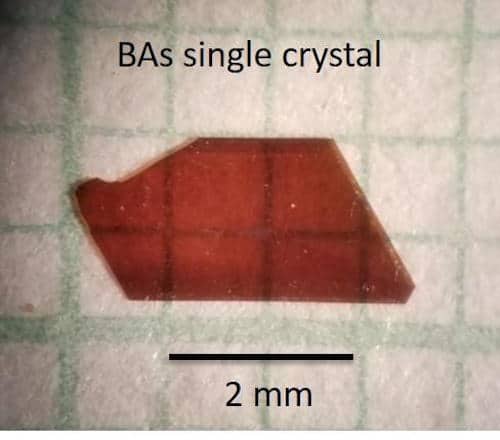
Unwanted heat is a big problem in modern electronic systems that are based on conventional silicon circuits – and the problem is getting worse as devices become ever smaller and more sophisticated. Carrying away this heat is critical and researchers are developing efficient heat-conducting materials to meet this challenge. Three teams from around the US are now saying that crystals of the semiconductor boron arsenide (BAs) show promise in this context and they have measured a high thermal conductivity of more than 1000 W/m/K at room temperature for this material. This value is three times higher than that of copper or silicon carbide, two materials that are routinely employed for spreading heat in electronics.
“The value we measured (on crystal sizes of about 0.5 mm) is surpassed only by diamond and the basal plane value of graphite,” says Bing Lv of the University of Texas (UT) at Dallas, who led one of the research groups together with David Cahill of the University of Illinois at Urbana-Champaign.
The other two groups, led by Zhifeng Ren of the University of Houston (UH) and Yongjie Hu of the University of California at Los Angeles (UCLA) measured local thermal conductivities of 1000 W/m/K and 1300 W/m/K respectively, with Ren’s group also measuring a value of 900W/mK on large crystals of about 4 mm x 2 mm x 1 mm.
“The UH/UT Austin paper reported transport data of about 900 W/m/K across a length of at least 2 mm using Raman spectroscopy across the same distance and TDTR, finding about 1000 W/m/K locally on a spot less than 20 microns,” explains Ren.
Predicted thermal conductivity as high as that of diamond
Researchers predicted that BAs should have a theoretical thermal conductivity as high as that of diamond (2200 W/m/K), which is the best heat conductor known, back in 2013. However, to reach this high value, high quality crystals are needed since defects and impurities dramatically degrade thermal properties.
Lv and colleagues, then at the University of Houston, made BAs crystals in 2015 but the material only had a thermal conductivity of 200 W/m/K. Since then the researchers have optimized their crystal-growing process using a modified version of a technique called chemical vapour transport. Here, they place boron and arsenic in a chamber containing hot and cold areas and the two elements are then transported (by different chemicals) from the hot end to the cooler end, where they combine to form crystals.
Heat in crystals is carried by phonons (which are vibrations of the crystal lattice). Lv explains that the large differences in the masses of boron and arsenic atoms creates a big frequency gap between acoustic and optic phonons, which allow the phonons to travel more efficiently through the crystals. The researchers measured the thermal conductivity of their BAs using a method called time-domain thermoreflectance or TDTR, which was developed in Cahill’s lab in Illinois.
Ren’s team also used chemical vapour deposition to make their large crystals (measuring 4 mm x 2 mm x 1 mm, as mentioned). These are a significant improvement on the ones they previously made, which were less than 500 microns across and were thus too small for certain measurement techniques. The researchers also measured the thermal conductivity of their BAs using TDTR as well as some other techinques.
Hu and colleagues, for their part, made BAs single crystals more than 2 mm in size with undetectable defects and measured their thermal conductivity using the TDTR technique. Their spectroscopy study combined with atomistic calculations reveal that the phonon vibration spectrum of BAs allows for “very long phonon mean free paths and strong high-order anharmonicity through a four- phonon process”.
First known semiconductor with ultrahigh thermal conductivity
The result from all three groups mean that BAs is the first known semiconductor with a bandgap comparable to silicon of around 1.5 eV to have an ultrahigh thermal conductivity and it could be a revolutionary thermal management material, according to the researchers.
And that is not all: “There is also a close match between the thermal expansion coefficients of BAs and silicon. This is a non-negligible advantage for minimizing thermal stresses and reducing the need for thermal interface materials when incorporating it into conventional semiconducting devices,” says Lv.
“Our team is now busy looking into other processes to improve the yield of this material for large-scale applications,” he tells Physics World. “We are also trying to control the types of defects that are present in these crystals and better understand how they affect its thermal conductivity.”
The research is detailed in three papers in Science.


